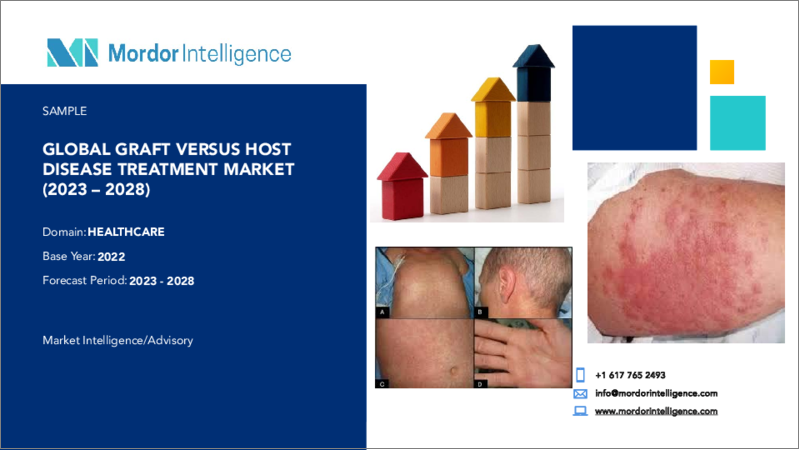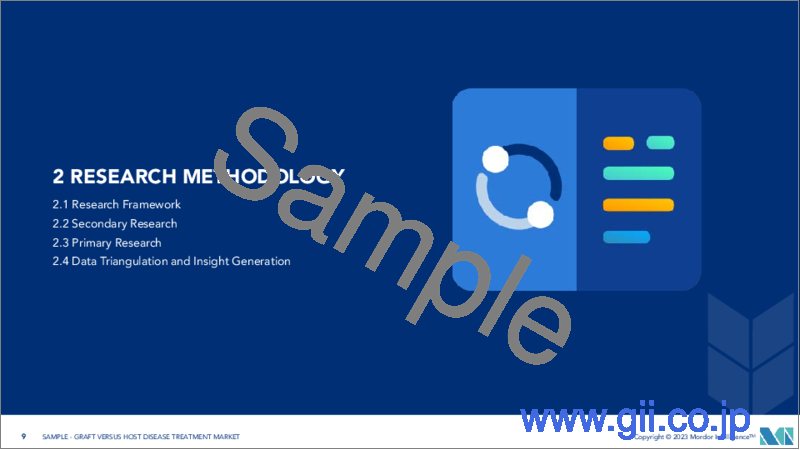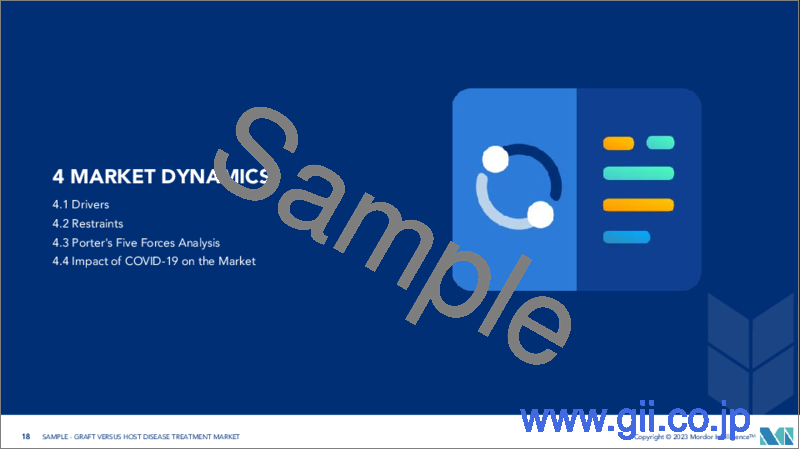|
|
市場調査レポート
商品コード
1197053
移植片対宿主病治療市場- 成長、動向、予測(2023年-2028年)Graft Versus Host Disease Treatment Market - Growth, Trends, and Forecasts (2023 - 2028) |
||||||
|
● お客様のご希望に応じて、既存データの加工や未掲載情報(例:国別セグメント)の追加などの対応が可能です。 詳細はお問い合わせください。 |
|||||||
| 移植片対宿主病治療市場- 成長、動向、予測(2023年-2028年) |
|
出版日: 2023年01月23日
発行: Mordor Intelligence
ページ情報: 英文 120 Pages
納期: 2~3営業日
|
- 全表示
- 概要
- 目次
移植片対宿主病治療市場は、予測期間(2022-2027年)にCAGR8.4%で成長すると予測されています。
COVID-19のパンデミックは、市場の成長率に大きな影響を与えています。移植片対宿主病(GvHD)は、同種移植を受けた人に発生する疾患です。ドナーの免疫細胞がレシピエントの体内臓器を攻撃し、「サイトカインストーム」を引き起こします。サイトカインストームとは、炎症性サイトカインが過剰に産生されることを指し、その結果、局所的な臓器障害を引き起こす可能性があります。2021年にNatureに掲載された「Systemic and organ-specific immune-related manifestations of COVID-19」と題する総説の通り、COVID-19の発症時にも同様の状態が起こり、感染者の免疫系が炎症性サイトカインを増加させ、臓器不全に陥ります。このように、COVID-19に罹患すると、GvHDの重症度が上がります。合併症の増加は、COVID-19の流行期には、世界のヘルスケアシステムに深刻な課題を突きつけました。したがって、COVID-19のために発症したさらなる合併症に対抗するために、移植片対宿主病治療薬の需要が急増したのです。
骨髄または造血幹細胞治療の割合の増加、急性GvHDの発生率の増加、およびパイプライン薬剤の増加は、分析期間を通じて市場の成長を推進する可能性が高いです。例えば、2021年10月にStatPearls Publishingが発行した「Graft Versus Host Disease」と題するレポートによると、ヒト白血球抗原(HLA)が一致した同胞からHCTを受けた患者の急性GvHDの発生率は約50%であり、非一致ドナーではさらに高い範囲であることが判明しています。慢性GvHDの発生率は6~80%の範囲であることがわかりました。さらに、「Epidemiology and Treatment of Chronic Graft-versus-Host Disease Post-Allogeneic Hematopoietic Cell Transplantation(同種造血細胞移植後の慢性移植片対宿主病の疫学と治療。2021年6月にElsevier社から出版された「A US Claims Analysis」によると、米国では、42%の患者が同種造血幹細胞移植後3年以内にcGvHDを発症しており、cGvHDを発症した患者の66%が急性GvHDを事前に有していることが判明しています。cGvHDの難治性により、GvHD治療市場の成長が促進されると予想されます。
さらに、より多くの研究は、市場の成長にプラスの影響を与えるGvHD治療のための薬に焦点を当てています。例えば、「New Approaches for the Treatment of Chronic Graft-Versus-Host Disease」と題された総説があります。2020年10月にFrontiers in Immunologyに掲載された「Current Status and Future Directions」では、慢性GvHD(cGvHD)患者の約50%-60%に第二選択治療が必要であることが明らかにされています。cGvHDに対抗するために、B細胞やT細胞を標的として免疫調節を行い、それによって炎症を抑え、病気の重症度を軽減させるいくつかの新しい戦略が研究されています。さらに、2020年5月の国立がん研究センターによる最近のニュース記事では、無作為化臨床試験に基づいて、他の治療に反応しないGvHD患者の治療に対するルキソリチニブの使用が調査されています。
業界プレーヤーと政府による研究開発能力への高い投資は、市場に有利な機会を生み出すと予想されます。例えば、2021年6月、Equillium, Inc.は、急性移植片対宿主病(aGvHD)患者の第一選択治療におけるイトリズマブの米国食品医薬品局(FDA)とのエンドオブフェーズ1会議の終了を報告しました。したがって、このような臨床試験の良好な結果は、新たな治療法につながる可能性が高く、予測期間中の市場の成長を後押しするものと期待されます。
したがって、上記の要因により、市場は予測期間中に成長すると予想されます。ただし、GvHD治療にかかる費用が高いことが、市場の成長を制限すると予想されます。
移植片対宿主病治療薬の市場動向
移植片対宿主病治療薬市場では、副腎皮質ステロイドセグメントが主要な市場シェアを占めると予想されます。
副腎皮質ステロイドセグメントは、対象疾患の負担増と調査研究の増加により、成長が見込まれています。副腎皮質ホルモンセグメントは、移植片対宿主病患者を治療するための副腎皮質ホルモンおよび副腎皮質ホルモン併用療法における研究開発の増加により、予測期間中に主要なシェアを占めると予想されます。さらに、2021年7月に発表された「ステロイド不応性慢性移植片対宿主病:治療オプションと患者管理」という論文によると、ステロイド不応性慢性移植片対宿主病を患う患者に対する第二選択治療が存在しないことが懸念されるとのことです。また、移植片対宿主病治療市場の拡大に利益をもたらす研究の巨大な範囲を実証しています。
さらに、米国人間健康サービス省の臓器調達・移植ネットワークによると、2021年に米国で約41,355件の移植が実施されました。移植片対宿主病は最も一般的に関連し、移植後に発生する可能性があるため、導入療法としてのコルチコステロイドの需要は患者集団の間で増加すると考えられ、最終的にセグメントの成長を促進することになります。
さらに、治療における副腎皮質ホルモンの効率を向上させるために実施される調査研究も、市場セグメントの成長を後押ししています。例えば、2022年6月現在、「Ruxolitinib-corticosteroid as first-line therapy for newly diagnosed high-risk acute graft versus host disease:study protocol for a multicenter, randomized, phase II-controlled trial」と題する臨床試験が進行中です。この試験は、新規に診断された高リスクのaGvHDに対して、ルキソリチニブとコルチコステロイドの併用がコルチコステロイド単独より優れているかを評価する非盲検、多施設、2群の無作為化試験です。急性移植片対宿主病(aGvHD)に対する副腎皮質ステロイドの第一選択療法に対する奏効率は約50%であると報告されています。このような臨床試験の肯定的な結果は、効率性を向上させるため、将来的にセグメントの成長につながる可能性があります。
したがって、上記の要因から、この市場は予測期間中に成長すると予想されます。
北米が市場で大きなシェアを占めると予想され、予測期間中も同様と予想される
北米地域は、整備されたヘルスケアインフラ、研究開発の増加、移植件数の増加により、調査市場において大きなシェアを占めると予想されます。例えば、米国保健社会福祉省の下で運営されている臓器調達・移植ネットワークが2022年7月に更新したデータによると、2022年1月から2022年6月の間に米国で行われた移植の総件数は20,663件となっています。このような移植手術数の増加は、ドナーとレシピエントの適応免疫を介した移植片対宿主病治療の需要を押し上げ、市場の成長を促進する可能性があります。
さらに、規制当局からの承認も同地域の成長に寄与しています。例えば、2021年9月、米国食品医薬品局(FDA)は、12歳以上の患者において、従来の2つの治療法のいずれかが奏功しなかった後の慢性移植片対宿主病の治療にルキソリチニブの使用を承認しています。ルキソリチニブは、移植片対宿主病に伴うステロイド抵抗性を克服する薬剤であることから、有望な候補薬剤とされています。
さらに、2021年7月、米国食品医薬品局(FDA)は、慢性Graft-versus-Host病の治療薬としてBelumosudilを承認しました。この薬剤は、12歳以上の高齢者や、すでに他の2つの治療を試みた患者さんにも許容されます。このような承認は、同地域の市場の成長を後押ししています。
このように、上記の要因により、北米地域は予測期間中に大きな成長を見せると予想されます。
移植片対宿主病治療市場の競合他社分析
移植片対宿主病治療薬市場は競争が激しく、複数の大手企業で構成されています。市場シェアの観点からは、現在、少数の主要プレイヤーが市場を独占しています。現在市場を独占している企業には、Pfizer Inc.、Abbvie Inc.、Sanofi(Kadmon Pharmaceuticals), Sanofi(Genzyme), Incyte Corporation, Bristol Myers Squibb Company, Genentech Inc, Astellas Pharma US Inc.などの企業が挙げられます。
その他の特典
- エクセル形式の市場予測(ME)シート
- 3ヶ月間のアナリストサポート
目次
第1章 イントロダクション
- 調査の前提条件と市場の定義
- 調査対象範囲
第2章 調査手法
第3章 エグゼクティブサマリー
第4章 市場力学
- 市場概要
- 市場促進要因
- 骨髄または造血幹細胞治療の割合の増加
- パイプライン医薬品の増加
- 市場抑制要因
- 移植片対宿主病治療のコスト高
- ポーターのファイブフォース分析
- 新規参入業者の脅威
- 買い手/消費者の交渉力
- 供給企業の交渉力
- 代替品の脅威
- 競争企業間の敵対関係
第5章 市場セグメンテーション(金額ベース市場規模- 百万米ドル)
- 疾患別
- 急性移植片-宿主病
- 慢性宿主移植片病
- 製品別
- 副腎皮質ホルモン剤
- モノクローナル抗体
- チロシンキナーゼ阻害剤
- その他
- エンドユーザー別
- 病院内薬局
- オンライン薬局
- 小売薬局
- 地域別
- 北米
- 米国
- カナダ
- メキシコ
- 欧州
- ドイツ
- 英国
- フランス
- イタリア
- スペイン
- その他の欧州地域
- アジア太平洋地域
- 中国
- 日本
- インド
- オーストラリア
- 韓国
- その他アジア太平洋地域
- 世界のその他の地域
- 北米
第6章 競合情勢
- 企業プロファイル
- Pfizer Inc.
- Sanofi(Kadmon Pharmaceuticals)
- Astellas Pharma Inc.
- Incyte Corporation
- AbbVie Inc.
- Bristol Myers Squibb Company
- Sanofi(Genzyme)
- Genentech Inc.
第7章 市場機会と今後の動向
The Graft Versus Host disease treatment market is projected to register a CAGR of 8.4% during the forecast period (2022-2027).
The COVID-19 pandemic has had a significant impact on the market's growth rate. Graft-versus-Host disease (GvHD) is a condition that occurs in people who have received allogeneic transplantation. The donor immune cells attack the recipient's body organs and cause a "cytokine storm". A cytokine storm refers to the overproduction of inflammatory cytokines, which may result in local organ damage. As per a review titled "Systemic and organ-specific immune-related manifestations of COVID-19" published in Nature in 2021, a similar condition occurs during the incidence of COVID-19, where the immune system of the infected individual produces increased levels of inflammatory cytokines, resulting in organ failure. Thus, the severity of the GvHD increases when the patient is affected by COVID-19. The increase in complications posed a serious challenge to the healthcare system globally during the COVID-19 pandemic phase. Thus, there was a surge in demand for Graft-versus-Host disease treatment products to combat the further complications that developed due to COVID-19.
The increasing rate of bone marrow or hematopoietic stem cell treatment, the growing incidence of acute GvHD, and the increasing number of pipeline drugs are likely to propel the market growth throughout the analysis period. For instance, as per a report titled "Graft Versus Host Disease" published by StatPearls Publishing in October 2021, it was found that the incidence of acute GvHD was found to be about 50% for patients receiving HCT from Human Leukocyte Antigen (HLA) matched siblings, and the range was even higher in unmatched donors. The incidence of chronic GvHD was found to be in the range of 6-80%. Additionally, according to an article titled "Epidemiology and Treatment of Chronic Graft-versus-Host Disease Post-Allogeneic Hematopoietic Cell Transplantation: A US Claims Analysis" published by Elsevier in June 2021, in the United States, 42% of the patients had developed cGvHD within three years of allogenic HCT; 66% of those affected by cGvHD were found to have acute GvHD prior. The refractory nature of cGvHD is expected to propel the growth of the GvHD treatment market.
Furthermore, more research is focused on drugs for GvHD treatment that will have a positive impact on the market's growth. For instance, a review article titled "New Approaches for the Treatment of Chronic Graft-Versus-Host Disease: Current Status and Future Directions" featured in Frontiers in Immunology in October 2020 revealed that a second-line treatment is required for about 50% - 60% of chronic GvHD (cGvHD) patients. Several new strategies are being studied to combat cGvHD by targeting B cells or T cells for immune regulation, thereby reducing inflammation and diminishing the severity of the disease. Additionally, a recent news article by the National Cancer Institute in May 2020 investigated the use of ruxolitinib for treating GvHD patients who do not respond to other treatments based on a randomized clinical trial.
High investments in R&D capabilities by industry players and governments are anticipated to create lucrative opportunities in the market. For instance, in June 2021, Equillium, Inc. reported the completion of an End-of-Phase 1 meeting with the United States Food and Drug Administration (FDA) for itolizumab in the first-line treatment of patients with acute graft-versus-host disease (aGvHD). Thus, the positive outcome of such clinical trials will likely lead to new treatments, which will be expected to boost the market's growth over the forecast period.
Thus, owing to the abovementioned factors, the market is anticipated to project growth over the forecast period. However, the high cost of GvHD treatment is expected to limit the growth of the market.
Graft Versus Host Disease Treatment Market Trends
The Corticosteroids Segment is Expected to Hold a Major Market Share in the Graft-versus-Host disease treatment Market.
The corticosteroids segment is expected to grow owing to the growing burden of target disease and increasing research studies. The corticosteroids segment is expected to hold the major share in the forecast period due to increasing research and development in corticosteroid and corticosteroid combination therapy to treat HCT patients with Graft-versus-Host disease. Furthermore, according to the article titled "Steroid-refractory chronic graft-versus-host disease: treatment options and patient management" published in July 2021, the absence of second-line treatment for patients suffering from steroid-refractory chronic graft-versus-host disease is concerning. It also demonstrates the huge scope of research that helps benefit the expansion of the Graft-versus-Host disease treatment market.
Additionally, according to the Organ Procurement and Transplantation Network of the United States Department of Human Health Services, around 41,355 transplants were performed in the United States in 2021. Since graft versus host disease is most commonly associated with and might occur after transplants, the demand for corticosteroids as an introductory therapy is likely to increase among the patient population, ultimately driving the segment growth.
Furthermore, research studies carried out to improve the efficiency of the corticosteroids in the treatment are also boosting the growth of the market segment. For instance, as of June 2022, a clinical trial titled "Ruxolitinib-corticosteroid as first-line therapy for newly diagnosed high-risk acute graft versus host disease: study protocol for a multicenter, randomized, phase II-controlled trial" is ongoing. It is an open-label, multicenter, two-arm randomized trial that will evaluate whether the addition of ruxolitinib combined with corticosteroids is superior to corticosteroids alone in newly diagnosed high-risk aGvHD. It was reported that there is about a 50% response rate to first-line therapy with corticosteroids for acute graft versus host disease (aGvHD). The positive outcome of such clinical trials can improve efficiency and thus may lead to segmental growth in the future.
Thus, owing to the abovementioned factors, the market segment is expected to project growth over the forecast period.
North America is Expected to Hold a Significant Share in the Market and Expected to do Same in the Forecast Period
The North American region is expected to hold a significant share in the studied market owing to well-developed healthcare infrastructure, increasing research and development coupled with a growing number of transplants. For instance, according to the data published by the Organ Procurement and Transplantation Network, operated under the United States Department of Health and Human Services, updated in July 2022, the total number of transplants performed in the United States between January 2022 to June 2022 is 20,663. Such an increase in the number of transplant procedures may in turn boost the demand for graft versus host disease treatment owing to the immune-mediated response between donor and recipient adaptive immunity, thus propelling the market's growth.
Furthermore, the approval from the regulatory authority is also contributing to the growth in the region. For instance, in September 2021, the United States Food and Drug Administration (FDA) approved the use of Ruxolitinib for the treatment of chronic Graft-versus-Host disease after the failure of any two conventional treatments in patients aged 12 years or older. Ruxolitinib is a promising candidate drug since the drug helps to overcome steroid resistance associated with Graft-versus-Host disease.
Additionally, in July 2021, the United States Food and Drug Administration (FDA) approved Belumosudil for the treatment of chronic Graft-versus-Host disease. The drug is permissible for patients older than 12 years and older and those who have already attempted two other treatments. Such approvals are bolstering the growth of the market in the region.
Thus, owing to the abovementioned factors, the North American region is expected to show significant growth over the forecast period.
Graft Versus Host Disease Treatment Market Competitor Analysis
The Graft Versus Host disease treatment market is competitive and consists of several major players. In terms of market share, a few of the major players are currently dominating the market. Some of the companies which are currently dominating the market are Pfizer Inc., Abbvie Inc., Sanofi (Kadmon Pharmaceuticals), Sanofi (Genzyme), Incyte Corporation, Bristol Myers Squibb Company, Genentech Inc., Astellas Pharma US Inc., and others.
Additional Benefits:
- The market estimate (ME) sheet in Excel format
- 3 months of analyst support
TABLE OF CONTENTS
1 INTRODUCTION
- 1.1 Study Assumptions and Market Definition
- 1.2 Scope of the Study
2 RESEARCH METHODOLOGY
3 EXECUTIVE SUMMARY
4 MARKET DYNAMICS
- 4.1 Market Overview
- 4.2 Market Drivers
- 4.2.1 Increasing Rate of Bone Marrow or Hematopoietic Stem Cell Treatment
- 4.2.2 Increasing Number of Pipeline Drugs
- 4.3 Market Restraints
- 4.3.1 High Cost of Graft-Versus-Host Disease Treatment
- 4.4 Porter's Five Forces Analysis
- 4.4.1 Threat of New Entrants
- 4.4.2 Bargaining Power of Buyers/Consumers
- 4.4.3 Bargaining Power of Suppliers
- 4.4.4 Threat of Substitute Products
- 4.4.5 Intensity of Competitive Rivalry
5 MARKET SEGMENTATION (Market Size by Value - USD million)
- 5.1 By Disease
- 5.1.1 Acute Graft-Versus-Host disease
- 5.1.2 Chronic Graft-Versus-Host disease
- 5.2 By Product
- 5.2.1 Corticosteroids
- 5.2.2 Monoclonal antibodies
- 5.2.3 Tyrosine kinase inhibitors
- 5.2.4 Others
- 5.3 By End User
- 5.3.1 Hospital pharmacies
- 5.3.2 Online pharmacies
- 5.3.3 Retail pharmacies
- 5.4 Geography
- 5.4.1 North America
- 5.4.1.1 United States
- 5.4.1.2 Canada
- 5.4.1.3 Mexico
- 5.4.2 Europe
- 5.4.2.1 Germany
- 5.4.2.2 United Kingdom
- 5.4.2.3 France
- 5.4.2.4 Italy
- 5.4.2.5 Spain
- 5.4.2.6 Rest of Europe
- 5.4.3 Asia-Pacific
- 5.4.3.1 China
- 5.4.3.2 Japan
- 5.4.3.3 India
- 5.4.3.4 Australia
- 5.4.3.5 South Korea
- 5.4.3.6 Rest of Asia-Pacific
- 5.4.4 Rest of the World
- 5.4.1 North America
6 COMPETITIVE LANDSCAPE
- 6.1 Company Profiles
- 6.1.1 Pfizer Inc.
- 6.1.2 Sanofi (Kadmon Pharmaceuticals)
- 6.1.3 Astellas Pharma Inc.
- 6.1.4 Incyte Corporation
- 6.1.5 AbbVie Inc.
- 6.1.6 Bristol Myers Squibb Company
- 6.1.7 Sanofi (Genzyme)
- 6.1.8 Genentech Inc.




